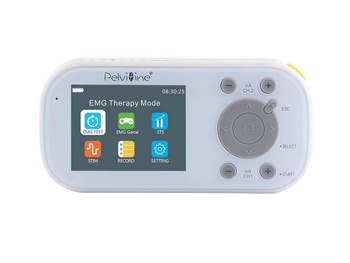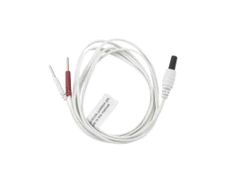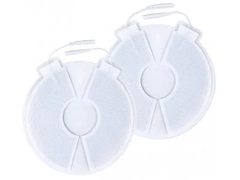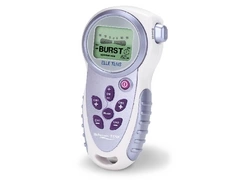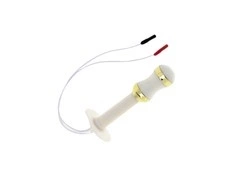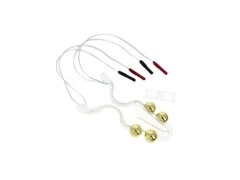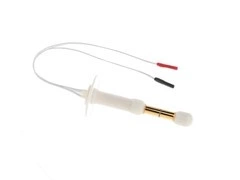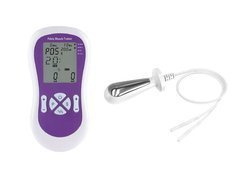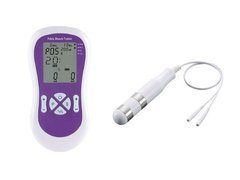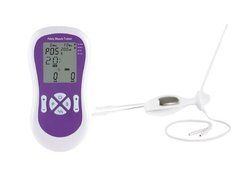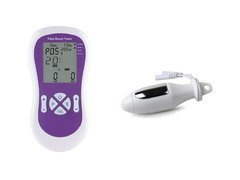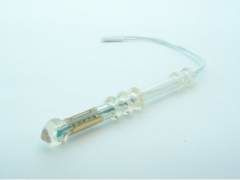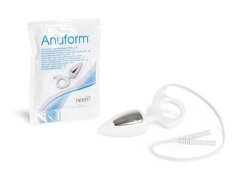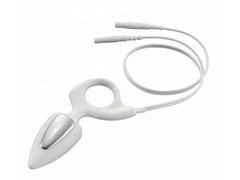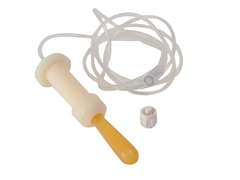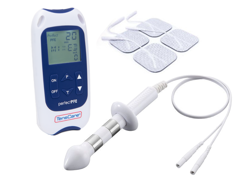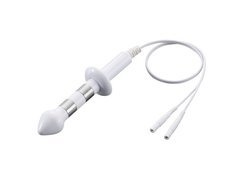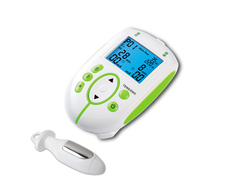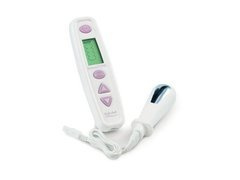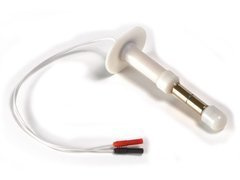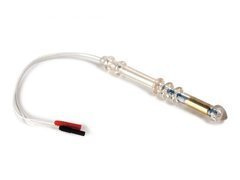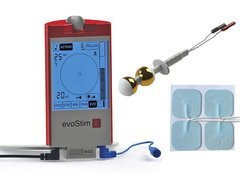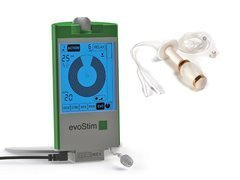Electrostimulation
( number of products: 56 )Pelvic floor muscle electrostimulation is one of the methods used in therapy to strengthen the pelvic floor muscles. It involves stimulating the muscles using electrical impulses delivered by Kegel muscle electrostimulators, which stimulate muscle contractions and relaxation. Electrostimulation is primarily used for urinary incontinence, weakened pelvic floor muscles after childbirth, pelvic surgery, or sexual dysfunction. Electrostimulation can be performed using special adhesive electrodes placed around the pelvic floor muscles or using vaginal or anal probes.
- 1
- 2
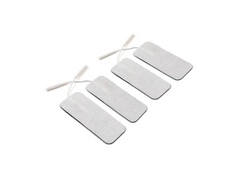
Bodyclock self-adhesive electrodes 40x100 mm for electrostimulation (4 pcs.)
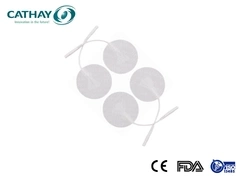
Self-adhesive CATHAY 32 mm round electrodes for electrostimulation (4 pcs)

Elektrostymulator SENSA TONE Body Clock na nietrzymanie moczu dla mężczyzn
- 1
- 2
Electrostimulation for Pelvic Floor Muscles – Effective Support for Intimate Health and Rehabilitation
Pelvic floor muscle electrostimulation is a safe, clinically proven method used to strengthen weakened pelvic floor muscles and support the treatment of various intimate dysfunctions. It is a valuable component of pelvic floor rehabilitation, especially in cases where voluntary activation of these muscles is difficult or insufficient. Using electrical impulses to stimulate muscle contractions, this therapy helps restore strength, endurance, and functional control of the pelvic floor.
In the category Electrostimulation at PelviCare, you will find devices and accessories dedicated to both home therapy and professional pelvic physiotherapy settings. Our selection focuses on solutions designed to improve comfort, restore intimate balance, and support long-term well-being.
What Is Pelvic Floor Electrostimulation?
Pelvic floor muscle electrostimulation (also referred to as EMS pelvic floor therapy) involves the use of gentle, targeted electrical impulses that activate the muscles responsible for supporting the bladder, uterus, rectum, and pelvic stability. The therapy is designed to mimic natural muscle contractions, making it particularly useful when the muscles are too weak to respond to traditional Kegel exercises alone.
Unlike general electrical stimulation for the body, pelvic floor electrostimulation uses specialized vaginal or anal probes, or external electrodes, depending on the patient’s needs and level of comfort. When applied correctly and consistently, stimulation helps retrain the neuromuscular system, improving both muscle tone and voluntary control.
Why Is Pelvic Floor Muscle Strength Important?
The pelvic floor muscles play a central role in everyday functioning. They stabilize internal organs, maintain continence, support posture, and contribute to sexual health. Factors such as childbirth, pregnancy, hormonal changes, surgery, aging, obesity, or a sedentary lifestyle can weaken these muscles over time.
When pelvic floor muscles become weakened or unable to activate properly, symptoms may include:
-
Stress urinary incontinence – leakage during coughing, sneezing, exercise
-
Urge incontinence – sudden, strong need to urinate
-
Mixed incontinence
-
Pelvic organ prolapse
-
Reduced sexual sensation or discomfort
-
Lower back or pelvic pain
Pelvic floor electrostimulation provides structured, measurable support in rebuilding muscular function, helping users regain both physical stability and confidence in everyday activities.
When Is Electrostimulation Used in Pelvic Therapy?
1. Urinary Incontinence
Pelvic floor muscle electrostimulation is widely recommended as part of urinary incontinence therapy, especially in stress and mixed forms. The electrical impulses strengthen the sphincter and surrounding pelvic muscles, improving bladder control.
2. Weakness of Kegel Muscles
When voluntary contraction is difficult or when pelvic muscles are underactive, electrostimulation serves as an effective training support. It allows users to “re-learn” how to activate these muscles correctly.
3. Postpartum Pelvic Floor Recovery
After childbirth, pelvic floor muscles may be overstretched or weakened. Electrostimulation helps guide safe and progressive muscle strengthening without excessive strain. It is often recommended as part of postpartum rehabilitation.
4. Pelvic Organ Prolapse Management
While electrostimulation is not a cure for prolapse, it can help improve muscular support and reduce discomfort by enhancing pelvic stability.
5. Pelvic Pain and Tension Regulation
Specific stimulation programs can help reduce pain, relax overactive muscles, and improve circulation in the pelvic region. This is beneficial for cases of pelvic floor hypertonicity or chronic pelvic pain.
Benefits of Pelvic Floor Electrostimulation
-
Improved muscle tone and endurance
-
Enhanced bladder control
-
Support for natural pelvic organ positioning
-
Improved sexual satisfaction and sensitivity
-
Strengthened core stability and posture
-
Non-invasive and safe therapy method
-
Suitable for home use with professional guidance
Consistent use leads to noticeable improvements in comfort, movement, and confidence during daily activities.
How Electrostimulation Works?
Neuromuscular Activation
Electrical impulses are delivered through a probe or surface electrodes, creating rhythmic muscle contractions. These contractions mimic voluntary exercise, helping to strengthen muscle fibers and improve neuromuscular signaling.
Muscle Fiber Recruitment
Pelvic electrostimulation supports the activation of both slow-twitch and fast-twitch muscle fibers, which are essential for:
-
Sustained organ support (slow-twitch fibers)
-
Sudden pressure control (fast-twitch fibers), such as when sneezing or laughing
Progressive Strength Training
Most devices offer adjustable intensity and program settings, allowing therapy to evolve with improving muscle strength.
Who Can Benefit from Pelvic Floor Electrostimulation?
-
Postpartum individuals recovering from childbirth
-
Women experiencing menopausal pelvic changes
-
People with stress, urge, or mixed urinary incontinence
-
Those struggling with weak pelvic muscle activation
-
Individuals undergoing pelvic floor physiotherapy
-
Anyone advised by a pelvic health specialist to support muscle rehabilitation
Before beginning therapy, consultation with a pelvic physiotherapist or medical specialist is recommended to tailor treatment to individual needs.
Home vs. Clinical Electrostimulation Devices
Home Devices
Designed for comfort, simplicity, and daily routine use. Ideal for users who want to support pelvic therapy independently under remote or initial guidance.
Clinical Devices
Used by pelvic physiotherapists, offering advanced settings, diagnostic functions, and real-time muscle activity feedback.
At PelviCare, we offer high-quality devices for both home therapy and professional clinical practice.
How to Use Pelvic Floor Electrostimulation Safely
-
Always begin with guidance from a pelvic health specialist.
-
Start with low intensity and gradually increase according to comfort.
-
Use only medical-grade probes and electrodes intended for pelvic use.
-
Maintain proper hygiene and follow manufacturer instructions.
-
Discontinue use and consult a specialist if pain occurs.
Explore Electrostimulation Devices at PelviCare
Our category includes:
-
Pelvic floor electrostimulation devices
-
Vaginal and anal probes
-
Surface electrodes for external stimulation
-
Accessories and replacement parts
Each product is selected for safety, comfort, and clinical effectiveness. Whether you’re starting your rehabilitation journey or enhancing an existing therapy plan, our solutions help support daily pelvic health.
Support Your Pelvic Floor with Confidence
Electrostimulation is a powerful, research-based method that helps restore pelvic strength, improve continence, and enhance quality of life. By incorporating pelvic floor muscle stimulation into your therapy plan, you invest in lasting comfort, functional well-being, and confident everyday living.
Explore our selection to find the right device for your needs—and take an important step toward restoring balance and control.

